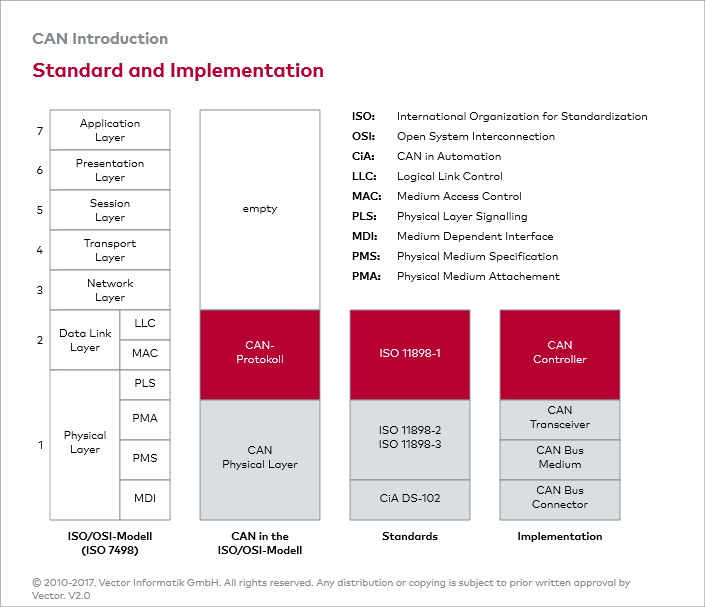- Overview
- 1. Introduction
- 2. CAN Communication
- 3. CAN Framing
- 4. CAN Bus Access
- 5. CAN Data Protection
-
6. CAN FD
- Motivation
- Advantages and Consequences
- New Types of Frames
- Details of a CAN FD Frame
- Distinguishing CAN from CAN FD Frames
- Compatibility of CAN and CAN FD Controllers
- Accelerated Transmission
- Indicating too many Errors
- Length of the Data Field
- More Data with the same Security
- Changed Rules for Bit Stuffing and CRC Calculation
Standardization
CAN protocol
CAN technology has been standardized since 1994 and is described by four ISO documents. ISO 11898-1 describes the CAN protocol. In relation to the reference model of data communication, the CAN protocol just covers the Data Link Layer (MAC — Medium Access Control, LLC — Logical Link Control) and the Physical Layer (PLS — Physical Signaling).
CAN controller
The CAN protocol is implemented in hardware. Many different CAN controllers have become available, which only differ in the way they handle the CAN messages. These differences manifest themselves in the object layer. A distinction is made between a CAN controller with object storage (so-called Full CAN Controller) and one without object storage (so-called Basic CAN Controller).
CAN High Speed & CAN Low Speed
The two ISO documents ISO 11898-2 and ISO 11898-3 cover the two sub-layers of the reference model for data communication: PMA (Physical Medium Attachment) and PMS (Physical Medium Specification). They describe two different CAN physical layers: the high-speed CAN physical layer and the low-speed CAN physical layer. They differ primarily in their definition of voltages and data transmission rates (data rates).
Data rates
ISO 11898-3 allows data rates up to 125 kbit/s. It is primarily used in the convenience area of the automobile. ISO 11898-2 allows data rates up to 1 Mbit/s. Consequently, ISO 11898-2 is primarily used in the powertrain and chassis areas of the automobile.
No standard exists for the MDI (Medium Dependent Interface) sub-layer of the physical layer. CiA DS-102 (CiA: CAN in Automation) only recommends the use of very specific connectors (SUB-D9) as well as conformance to a very specific connector pin assignment.
Event driven communication
ISO 11898-1 defines an event-driven communication. With a higher bus load this may lead to delays, especially for lower priority CAN messages. To assure deterministic communication in a CAN network, ISO 11898-4 is available. ISO 11898-4 is an extension of the Data Link Layer that adds a time triggered communication option for CAN-based networks.
ISO/OSI reference model
The figure “Standard and Implementation” shows the relationships between the ISO/OSI reference model of data communication, the CAN standard and its implementation.

